Trying to move gas from one can to another? Need to empty water from a pool or a pond?
Siphoning is a job that most of us will encounter sooner or later, and one that many folks deal with on a regular basis. When attempting it for the first time, most don’t know where to begin or even really what it is. There are actually several ways to go about siphoning water, and an improper technique can lead to a mouth full of water, or liquid that doesn’t move.
Whether you’re emptying a pool, cleaning a fish tank, removing water from a hole in your backyard, working on a toilet, or trying to get a longer transfer going, a proper siphon will be the fastest and most effective way to tackle the job.
What You Need
You probably already have all of the supplies you need to complete the task in a standard way, and if not, they can be found easily at your local home improvement store. A single garden hose is all that’s required for the most basic set-up, but by adding extra hoses, valves and other stuff, you might save yourself some time and effort when siphoning water. To make the job as easy as possible, you may want to consider getting a siphon starting tool, but if you want to get started right away, just grab the hose from your backyard and follow the instructions below.
The list below details the three most popular traditional ways to siphon water, and below that you’ll find directions for a much easier way that you may be interested in as an alternative. The easy way does require a specialized tool, but based upon the time, effort and annoyance it can save you, the cost is relatively small.
What Is A Siphon?
The term itself actually stems from an Ancient Greek word for pipe or tube. It can generically refer to any number of devices that allow water to flow through, but in most cases it is used to describe an upside down, u-shaped hose that causes water to flow uphill without a pump. In order for it to work correctly, pressure needs to be different on the opposite ends.
Under normal conditions, water flows from high to low, but when the lower end of a tube is pressurized, the liquid can flow from low to high. In this way, increased pressure pushes water upwards to the low pressure zone at the top of the arch, and then it falls down the other side as gravity sucks it down and out. The power of gravity will continue to pull water up and over once the process is started, and as long as the tube stays full.
For good results, the container to be emptied should be higher up than the location you want liquid to drain into.
Want to know more? Check out the wikipedia page.
Top 3 Traditional Ways To Siphon Water:
1. Use a Faucet and Garden Hose
This method is commonly used when working with a high volume of liquid stored in a larger container. The wide diameter of the garden hose is an advantage in a case like this, but may pose a problem for smaller applications. Hooking up to a faucet while in place, or pre-filling can be a bit faster than submerging, but based upon the exact technique you choose, it may be more than you want to tackle.
There are two slightly different ways you can go about siphoning water with the aid of your faucet, and both may require a trip to the store. For the first variation, you’ll use a single hose and two clamps, and for the other one, you’ll use two hoses and a special adapter.
When taking water out of an above ground pool, either one of these methods would work quite well.
Start A Siphon With One Hose:
- Select your location, and be sure that the water being drained is higher up than the area you want it to move it to. You can drain half a pool into your yard pretty easily, but if you want it completely empty, you’ll find it much more difficult. This is due to the elevation, and can be resolved if the hose goes down into a sewer or something that is lower than the ground.
- Clamp the male end of the hose shut to prevent water flow. Attaching certain nozzles with an on/off setting may also accomplish this same task, but with something you already have.
- Hook the non-clamped, female end to a faucet nearby and then turn it on to fill the hose.
- Once the hose is full, turn the water off, disconnect the hose, and clamp the end of the hose so that it remains full, and the water does not exit. If you are a clamp-less household, elevating the end and covering it securely with your hand may work if you move fast enough, but keeping the hose full is key. The liquid inside will provide the pressure situation necessary to start the siphon.
- Take either end and submerge it into the container you want to empty. You may want to secure it in place at the bottom, but make sure not to block the flow in the process.
- Place the other end in the area you want to send the liquid.
- Remove the clamp from the underwater side first, and make sure it does not float up.
- Remove the clamp at the other end and the water should start flowing immediately. The pressure along with gravity should keep it moving until the inflow side is empty.
- Watch the source end of the hose if not secured at the base. As the level lowers, it will become more important that it remains submerged.
- Once the pressure is gone, or the water reaches a certain level, the flow will terminate.
Start a Siphon With Two Hoses:
If you have two hoses and a shut off valve to connect them, this method can be easier than the one above. It doesn’tt require you to transport a full hose, so there is less room for error. If you feel like the one hose way will lead to frustration, a small purchase can make it a more fool-proof operation.
- Select locations in the same way as above.
- Insert and submerge one end of your garden hose into your full container and secure it in place if possible. Make sure not to cut off the water flow if anchoring the hose in place.
- Place the other end of your garden hose in the location you want the water to flow into.
- Screw on your shut off valve and make sure it is open.
- Attach your other hose to the unused end of the valve and then hook up the other side of the second hose to a faucet.
- Turn on the faucet and allow the hose to fill.
- Once the first hose is full, shut the valve to contain the water and then disconnect the second hose. Make sure to turn the faucet off first.
- To begin moving water, simply open the valve to start the flow.
- As the water level lowers, make sure the source end of the hose stays submerged.
2. Submerge a Garden Hose
If you don’t want to mess around with dragging a full hose across your yard, or purchasing special parts for the job, then you can try the submersion method which basically means that you will fill the hose or tube in the location you wish to empty. Although this works for larger containers like pools, spas and ponds, it may not be the easiest way to go for every situation. For smaller amounts of water, or easier to access locations, it can be quite effective. Because you don’t have to hook up to a faucet, you can use a garden hose or any other type of flexible tubing to complete the job.
- To begin, take your plastic tube and put the whole thing under the water in the container you want empty.
- You will see air bubbles begin to surface as water enters and air moves out. Once the air is gone, the tube should be full, but give it a shake to ensure prior to moving on to the next step. If not full, you will have problems.
- Once filled, take one end and cover it with your hand or thumb to hold pressure and keep the water inside. Make sure it is completely covered to prevent problems.
- Take the covered end out of the water and move it to another container or location that is lower than the one being emptied. Make sure it stays covered until you have it in the ideal location. Using a clamp can make this easier.
- Check to ensure the opposite end is not floating up and then release your thumb or clamp to start the flow of water. Liquid will travel up, over and out to the lower container.
- The water flow will continue until the source is empty, or the pressure is lost.
3. Use Your Mouth
This method can be fun, but for anyone that doesn’t want to find out the taste of the liquid you’re moving, it may not be the best choice. As with the other methods, you will be filling the tube to create needed pressure, but this time you’ll use your mouth to suck it full. If done correctly, you should not get any water down your throat, but that is a risk for any first-timer out there.
You may not always be able to fully submerge your hose, and you may not be close to a faucet or other water source. You’ll need to get the hose full one way or another, so this technique can be effective as a last resort.
If you visualize the up-side-down “u shape”, you basically want to continue sucking until the water reaches the top of the bend. As it flows over the bend, the siphon should be complete, and the water should keep flowing on it’s own. If you pay attention, and time it correctly, this technique works as well as any other.If you don’t pay close attention, you’ll end up with a mouth full of whatever liquid you are siphoning.
Good visibility can really decrease risk and improve results when using this method to siphon water so the hose from your backyard may not be the best option when choosing your supplies.
- To begin, place a bucket or some other container in a position that is lower than the water you wish to transfer.
- Place one end of your tube under the water, and take the other end over to your empty container.
- Start sucking on the dry end of the tube and make sure you remain lower than the end in the water.
- A clear tube works best for this method because stopping suction at the right time is pretty important. With the clear tube, you can see exactly what is going on.
- Watch the liquid and stop sucking as it gets to the top, and right before it begins to drop down. If emptying a bucket, you basically stop sucking as the water reaches the top rim.
- One the siphon has started, and the water is flowing, quickly and carefully place the end you were sucking into the bucket and let the water flow. Make sure not to raise the outflow end too high as you move it. This could stop the water.
- Ensure that the end submerged stays all-the-way under the water, and also make sure that the exit end of the hose stays lower than the intake. When both of these conditions are met, the flow will continue until the liquid is gone.
The Easy Way To Siphon Water
The easiest way to siphon water is to skip all of the sucking, and get right down to business. You could use stuff you already have at home, and you could build something yourself with parts you buy at the store, but you could also just buy a specialized tool that’s guaranteed to work.
For this job, doing it yourself can be more difficult than using a specialized tool. You can certainly get the same results if you try hard enough, but spending some money will eliminate any possibility of frustration, and also allow you to save time and effort when siphoning water or any other liquid.
Slide N Pump Siphon Starter and Manual Pump
 If you think all of those methods above require too much work or skill, then continue reading for a much easier way. The Slide N Pump is a clever tool that makes this job super easy, and it also eliminates almost any possibility of error or trouble. You will need to pay money for the tool, but you will then have a fast and simple way to siphon water or any other liquid anytime you need to.
If you think all of those methods above require too much work or skill, then continue reading for a much easier way. The Slide N Pump is a clever tool that makes this job super easy, and it also eliminates almost any possibility of error or trouble. You will need to pay money for the tool, but you will then have a fast and simple way to siphon water or any other liquid anytime you need to.
It also works great as a regular pump, but in just seconds, it will fill a hose and provide the pressure necessary to initiate a steady stream of liquid without all the hassle. Attach any regular garden hose to give you the length you need, and a simple pump action will fill the hose with the water you want to get rid of. Once full, simply disconnect the pump and watch the water flow.
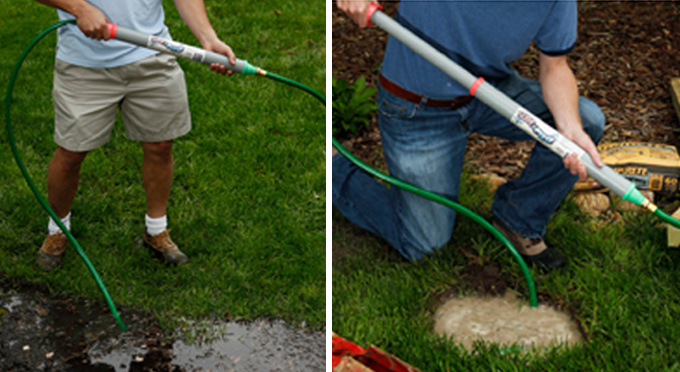
It is less messy, less time consuming and much faster than any of the three ways listed above, and because it is also a regular pump, you can use it to suck up any remaining water after the flow inevitably stops. The pump action also allows you to eliminate water when you can’t siphon due to conditions, and with every six back and forth movements, you’ll transfer one gallon of water.
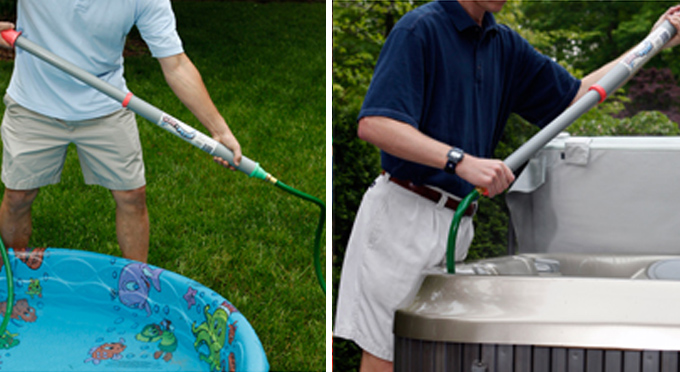
How To Use It:
- Attach a garden hose to the bottom end, or both ends of the tool.
- Submerge the inflow hose into the water and ensure that it remains underwater.
- Pump back and forth to fill the hose. You’ll be able to tell it’s full once it pumps out the end with every movement.
- Select a location for drainage that is lower than the area to be drained.
- Once the hose is full and the positioning is correct, the water will continue to flow.
- There are screens inside the pump to prevent clogging, but when they catch enough debris, they can also slow the flow. After the siphon is initiated, unscrew the tool and allow the water to flow through the hose alone. The liquid will keep moving as long as the pressure is maintained.
- Once the flow terminates, remove any remaining liquid by re-attaching the hose and using the tool like a pump. Place the inflow hose into the water and pump back and forth. A second hose on the exit end can help if this step becomes necessary in order to send it farther away.
The Slide N Pump is one of the best ways to tackle this job. Not only will you get things drained faster and easier, you’ll also have the ability to pump when conditions are not optimal, or when there is water left over. All siphoning methods are prone to leaving liquid behind, and this is one of the only methods that includes an easy way to deal with it.
If you don’t want to be drying left over puddles with a towel, or pulling your hair out because you can’t get the flow started, then this fool-proof tool is the answer. Anyone can use it because it requires no skill, practice or strength to operate. You may be able to save money by using stuff around your house and working to master a traditional technique, but you could also realize that your time is valuable, and messing around is for kids.
This handy tool will allow you to siphon water with ease, but you can also use it to bail a boat, empty a fish tank, clear a flooded ditch, fix a toilet and so much more.
Super Safety Siphon Hose
The Super Safety Hose is nothing more than a long clear piece of tubing with a fancy brass valve at the end. It’s similar to a basic siphon hose, but with the added valve, it takes care of all of the tough stuff for you. Because this handy siphon hose comes with a special mechanism that does all of the work, anyone can pick it up, and use it with great results the very first time.
You won’t need to fill it up, or pump any water in to make it work. It’s perfect for use in a wide range of situations, and you can use it with all sorts of liquids. Instead of pumping, all you need to do is give this hose a shake, and it will automatically fill and start a siphon. Just a few jiggles and the hose will begin to siphon water from one location to another. It almost looks like magic because of how fast and effortless this tool is to operate.
Where To Use It:
This tool is a great one to get BEFORE you need it. When you have it in your toolbox, you’ll eventually encounter a situation where it saves you time, money and effort. Whether you use it everyday, or keep it on hand for just-in-case, this affordable hose will pay for itself the first time you use it. Below is a list of some places you might use it, to give you an idea of what it can handle.
- Boats – Fill it with gas. Empty the gas tank. Use to empty the bilge.
- Automobiles – Drain and replace fluids.
- Lawn Mowers & Landscaping Tools – Fill tank without picking up a gas can.
- Tractors – Fill the tank in nay location.
- Motorcycles – Quickly refuel without lifting heavy jugs. Avoid spilling.
- Stopped up Sinks, Toilets and Tubs – Drain standing water. Empty toilets.
- Water Beds – Empty for transport or repair.
- Aquariums and Fish Tanks – Remove water for cleaning. Empty the tank for moving or storage.
- Ponds & Fountains – Drain for winter. Empty for cleaning.
- Pools & Hot Tubs – Remove water from cover. Empty or lower water level.
- Home Brewery’s – Use for bottling. Use to transfer from one container to another.
How To Use It:
You’ll be surprised at how easy this hose is to use, and how well it works. The special valve does everything for you, so anyone can siphon like a pro when they use it. You do want to make sure to use it properly to get the best results, but when operated properly, this is one of the best ways to move water, gas and other liquids. Follow the tips and instructions below to guarantee a good outcome.
- A siphon will only work when the setup is right. Although you can make water flow up and out of a container, you can’t actually make it flow uphill.
- To ensure that water will continue to flow once you get it started, make sure the location that the water is flowing FROM, is higher in elevation than the location the water is flowing TO.
- Once you have everything set up correctly, place the end without the valve into the TO location, and then place the end with the copper valve into the FROM location.
- For this tool, you’ll need a certain depth of water to get it to work. The copper valve needs to submerge as you shake it. Make sure that there is enough water to start a siphon before continuing.
- To start the siphon, use an up-and-down motion to prime the hose. Similar tools are referred to as jiggler hoses, or shaker siphons due to the action required, but a more deliberate, downward motion, and then quick upward motion works best.
- Each time you thrust downward, liquid will enter the tube, and when you move back up, the valve will shut, and prevent it from leaving.
- Continue the up and down jiggling motion until the hose fills with water to the point of curving over the top bend.
- Once water begins to flow over the top, gravity will take over, and the water flow will continue at nearly 4 gallons per minute.
- Once the water is flowing on it’s own, pressure inside the tube will create a vacuum that allows you to suck out nearly every last drop from the inflow location.
- Once the job is done, carefully remove the hose, and be careful. There could be residual material inside the tube.
- Rinse out to clean, and hang or stow in a drawer for storage. It’s totally reusable.
If you have liquid that you want to move to another place, or eliminate completely, then you may need to start a siphon to get the job done. In most cases you’d be there all day long bailing with a bucket, drying with a sponge, or pumping at a slow rate. When you siphon water to move it to another location, it’ll move quickly and continue without any effort on your part. Just get it started, and then walk away. The water in one location will lower as it is transferred to the spot where you really want it.
Stop thinking that this is a job that only pros can handle. If you follow the instructions properly, or if you get a tool to eliminate the guess-work, you can easily siphon water all-by-yourself.

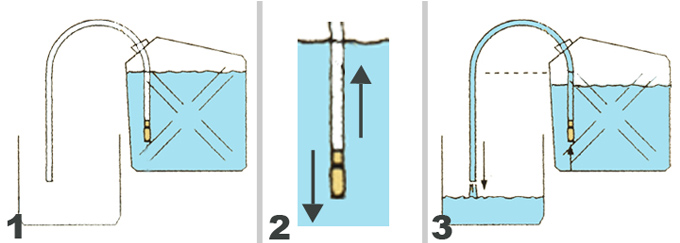
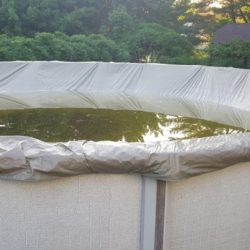
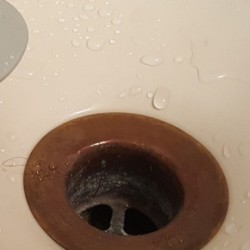


 Ordering Info
Ordering Info Customer Service
Customer Service Follow Us
Follow Us Search For Stuff
Search For Stuff Find Us
Find Us Call Us
Call Us Pay Us
Pay Us

I made few automated syphons to drain the water from pool cover. Connected to a faucet a water timer has a sensor to signal
when there is water in the pool cover, if there is water the timer opens the valve for a programmed time to a two hoses system and it activates the syphon, the syphon will suck the water like a manual system, the valve opening is programmable to be repeated. The timer is operated by two 1.5 volts batteries.
Do you see a market for this system?
Sounds pretty cool. There are plenty of lazy people out there, so if the cost is right, and the operation is flawless, it could be a good product. Why go outside and do work when you could set up an automatic robot thingy to do it for you? right?!
Hi. I am looking for a solution to stop this siphon automatically. I have setup a automatic drip-irrigation on my apartment terrace. It looks something like this https://energypedia.info/images/8/8c/DripIrrigation.png
The difference is that the tank does not have a tap, like that in the image, but I have a small water-cooler pump(40W) which generates enough power to lift the water out of my 300L(4ft) tank. The problem is that, once I switch off the pump, I expect no more water to leave the tank, but it keeps on leaving until the level in the tank comes down considerably. I think the effect described here could be behind water flow after turning off the pump.
Is there a way to stop water flow once the pump is switched off??
Flow control valve, piped in line with the pump. Pump shuts off and the control valve closes. Operates on low voltage ,
my dad showed me the last one back in the 1930s when we lived on a sheep ranch. I still use it today, I passed it on down the line…
need a real kind of hand siphon pump, to pump out a muddy ditch, or trench, , , gravity p[lus a filter are the 2 problems, , since ditch or trench is lower than the yard., , and a filter has to be able to filter out the muddy water, small rocks, , the man that invents this will , people will buy it., need non electricl ways, and without getting to complicated., not lazy, just need other low cost ways besides, bucket and boots, rainsuit.
This is great information. Knowing how to siphon water is important. Thanks for sharing.
There’s certainly a lot to know about this subject. I love all of the points you’ve made.
Appreciate the recommendation. Let me try it out.